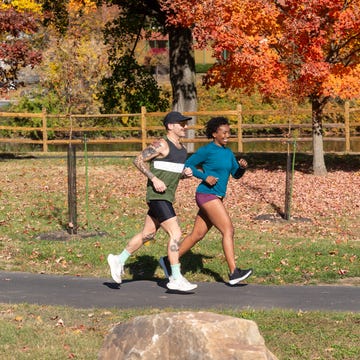There’s something exhilarating about one single, solitary mile.
Ever since Roger Bannister famously ran the first sub-four minute mile back in 1954, athletes are constantly pushing the boundaries of this distance: This past February, Jakob Ingebrigtsen broke the indoor mile world record, less than a week after Yared Nuguse had set it. Just this month, Jane Hedengren broke the U.S. high school mile record by nearly five seconds. Two years ago, Faith Kipyegon set the fastest women’s mile time, clocking 4:07.64. Today, she attempted to break the four-minute barrier for the first time in history, coming in at 4:06.42 for Nike’s Breaking4 event.
You don’t have to be an elite to recognize how iconic these 1,600 meters are. “Any runner ever will ask you: ‘What’s your mile time?’” says Rebeka Stowe, a professional runner, Nike Run Club coach and former Olympic Trials qualifier. “It’s got that amazing combination of speed and aerobic strength, and it’s just long enough that it challenges your ability to stay focused and tactical. There’s just an energy around it.”
It’s also an incredibly accessible distance for new and experienced runners, whether they’re looking for a fun short-term challenge or an opportunity to improve their speed for longer distances.
If you’re ready to chase your fastest mile time, we have all the advice you need, including a four-week training plan.
How to Prepare to Race 1 Mile
Before flooring the gas pedal, you should have a four- to eight-week aerobic base—think 5K or 10K training—under your belt, says Stowe. “That will have given you a touch of aerobic power work, not just a purely aerobic endurance base,” she says. “And you’re going to need that strength when you’re 1,200 meters in.”
When you’re ready to zero in on mile-specific training, focus on tapping into top speeds for shorter efforts than the race distance. You can develop speed and power through interval training, which research shows will make you both faster and fitter in less time than steady-state cardio.
But mile training isn’t just about speedwork. “One day or one workout is not the key to success,” says Stowe. “It’s about a comprehensive program with lots of variation and consistency.”
When it comes to your training and racing, you may want to consider training in a different pair of shoes than you race in. Some shoes are better built to withstand the higher mileage you’ll put in during training, while others are strategically designed to feel extra fast on race day.
“Having a pair of shoes to use for training and a separate pair specifically for racing—if the two-shoe option is available to you—is a smart and worthwhile move,” says running and strength coach, Jess Movold. “If you get a pair to use specifically for racing, make sure to break them in slightly by wearing them on a few easy runs before race day. I suggest running at least a 5K in your new shoes before racing in them.”
“The benefit of having a race-specific shoe is that they will last you a long time,” adds Movold. “You can break them out for races as special occasions but otherwise keep the mileage on them low so they stay fresh and responsive on race day.”
Now for training to run faster in those shoes, we have a four-week training plan below from Stowe and fellow Nike Run Coach Jes Woods.
Your 4-Week Mile Training Plan to Get Faster
On Mondays, you’ll do speedwork, starting with paces faster than your goal mile pace to force you to recruit proper running form and mechanics. Then, you’ll progress from shorter to longer efforts over the course of the month, so you can eventually sustain that goal mile pace.
You’ll do a second quality workout on Thursday, but these should be more relaxed and fun—think: moderate effort over all-out speed. Make sure to incorporate a 1-mile warmup as well as some dynamic drills and a 1-mile cooldown into each workout.
WEEK 1:
- Monday: 2-5 miles easy, end with 6 x 20 seconds fast with 90 seconds of recovery in between
- Tuesday: 2-5 miles easy
- Wednesday: OFF
- Thursday: 2-5 miles easy, with 2-3 x 5 minutes at moderate pace
- Friday: OFF
- Saturday: 30-60 minutes long run, easy pace
- Sunday: 2-5 miles easy
WEEK 2:
- Monday: 2-4 x 200-meter sets: 1 rep @ 10K pace; 1 rep @ 5K pace; 2 reps @ goal mile pace with 90 seconds of recovery in between reps and sets
- Tuesday: 2-5 miles easy
- Wednesday: OFF
- Thursday: 2-5 miles with 20- to 30-second hill repeats with 90 seconds of recovery in between
- Friday: OFF
- Saturday: 30-60 minutes long run, easy pace
- Sunday: 2-5 miles easy
WEEK 3:
- Monday: 2-3 x descending ladder workout: 600 meters, 400 meters, 200 meters (or 3 minutes, 2 minutes, 1 minute) with 90 seconds of recovery in between
- Tuesday: 2-5 miles easy
- Wednesday: OFF
- Thursday: 2-5 miles with 6-8 x 45-second pickups with 90 seconds of recovery in between
- Friday: OFF
- Saturday: 30-60 minutes long run, easy pace
- Sunday: 2-5 miles easy
WEEK 4:
- Monday: 3 x 600 meters at mile pace with 90 seconds of recovery in between
- Tuesday: 2-5 miles easy
- Wednesday: OFF
- Thursday: 2-5 miles easy, with 2 x 10 minutes at moderate pace
- Friday: OFF
- Saturday: 30 minutes long run, easy pace
- Sunday: OFF
WEEK 5:
- Monday: RACE!
- If you are signed up for an actual race that does not fall on a Monday, use the days before the event to taper your training and allow your body to fully recover and prepare for the effort ahead. Perform a shakeout run one or two days before the race that’s 1 to 2 miles easy with 4 to 6 strides at end and perform a proper warmup before the event. Good luck!














